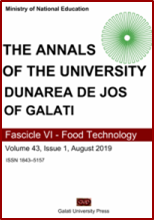The validity of an x-ray scatter approach for the detection of olive oil adulteration
Abstract
X-ray scattering from biological samples was used in tissue characterization due to its dependence on the molecular structure of biological samples. This work aimed to investigate its validity in the detection of the adulteration of Virgin Olive Oil (VOO) with Corn Oil (CO) compared to the well-known viscosity and UV-Visible absorption spectroscopy techniques. Results showed that despite the favorable linear dependence of oil viscosity on the percentage of adulterant (0%, 20%, 40%, 60% and 80%), yet reliable difference from pure VOO seemed to exist only for CO percentages of 40% or
above. Surprisingly, X-ray scatter profile parameters - Area Under Curve (AUC) and peak height showed valid variations from pure VOO for the same CO percentages. On the other hand, UV-Visible absorption peaks at 465 and 670 nm showed significant differences between all concentrations of adulterated samples and control. Nevertheless, the introduction of a technique capable of probing the changes in molecular structure provides new perspective for the confirmation of the detection of VOO adulteration.


